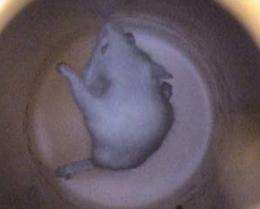September 11, 2009 weblog
Mice Levitated for Space Research

(PhysOrg.com) -- Scientists have managed to levitate young mice in research carried out for NASA. Levitated mice may help research on bone density loss during long exposures to low gravity, such as in space travel and missions to other planets.
The researchers worked from a number of laboratories around the U.S., including the Jet Propulsion Laboratory in Pasadena, California and the University of Missouri. The research was done on behalf of NASA, and was published in the online journal Advances in Space Research on 6 September 2009.
The scientists built a variable gravity simulator consisting of a superconducting magnet that could generate a magnetic field strong enough to levitate the water inside every cell in the mouse's body. Water is weakly diamagnetic, which means that in the presence of a strong magnetic field the electrons in water rearrange orbit slightly, creating tiny currents in opposition to the external magnetic field. If the external magnet is strong enough, the diamagnetic repulsion of the water in the mouse tissue is enough to exactly balance the force of gravity on the body.
Scientists have previously levitated live grasshoppers and frogs, but this is the first time a mammal has been levitated. The mice were confined to a plastic cage, which had a base with holes to allow waste to be removed, and an open top to allow in air, food, water, and to allow the proceedings to be filmed. The cage was not necessary for the levitation, but it did allow the scientists to compare the levitated mice with non-levitated subjects in identical cages.
The first subject to be levitated was just three weeks old. The tiny mouse was disturbed and disoriented and began to spin when it kicked out as though trying to find something to hold on to. With no friction to stop the spinning, the mouse became even more disoriented, according to Jet Propulsion Lab physicist Yuanming Liu.
The next young mouse was mildly sedated before being levitated, and it was less agitated by the experience. The levitation experiments were repeated a number of times, and showed that the mice quickly adjusted to the conditions, even eating and drinking normally after a few hours of levitation. Even without sedation, the mice became quite comfortable floating in zero gravity.
The powerful magnetic field seemed to have no short term effects on the mice, and earlier studies on rats showed there were no ill effects even after 10 weeks' exposure to strong magnetic fields.
The researchers are now applying for research funding that will allow them to study the physiological effects of prolonged exposure to microgravity, and to try to develop countermeasures that astronauts could adopt.
More information: Magnetic levitation of large water droplets and mice; Yuanming Liua, Da-Ming Zhub, Donald M. Strayera and Ulf E. Israelssona, Advances in Space Research, http://dx.doi.org/10.1016/j.asr.2009.08.033
© 2009 PhysOrg.com

















